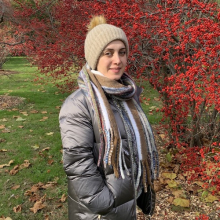Maliga Lab | Waksman Institute of Microbiology (original) (raw)
Research Overview
Plastids are semi-autonomous organelles with a relatively small (120-180 kb), highly polyploid genome present in 1,000 to 10,000 copies per cell. The best-known plastids, chloroplasts, convert sunlight into chemical energy. Plastid engineering, in contrast to nuclear engineering, offers higher protein yields, the opportunity to express several genes controlling complex traits, and natural tool to prevent transgene flow via pollen. We have developed protocols for transformation of the tobacco (Nicotiana tabacum) plastid genome, efficient post-transformation excision of the marker genes, and high-level expression of recombinant proteins.
Our current research interests are in the development of efficient plastid transformation protocols in the model plant Arabidopsis thaliana and the related oilseed crop Brassica napus. As an alternative to biolistic DNA delivery, we are working on chloroplast transformation by Agrobacterium. Additionally, we are interested in building synthetic chloroplast operons and the expression of recombinant proteins for therapeutic applications.
Contact Information
Waksman Institute
190 Frelinghuysen Road
Maliga Lab
Piscataway, NJ 08854
United States
Selected Publications
Complete list of publications: [Google Scholar] [Pubmed]
The D1 polypeptide of the photosystem II (PSII) reaction center complex contains domains that regulate primary photochemical yield and charge recombination rate. Many prokaryotic oxygenic phototrophs express two or more D1 isoforms differentially in response to environmental light needs, a capability absent in flowering plants and algae. We report that tobacco (Nicotiana tabacum) plants carrying the Synechococcus (Synechococcus elongatus PCC 7942) low-light mutation (LL-E130Qin the D1 polypeptide (NtLL) acquire the cyanobacterial photochemical phenotype: faster photodamage in high light and significantly more charge separations in productive linear electron flow in low light. This flux increase produces 16.5% more (dry) biomass under continuous low-light illumination (100 μE m−2 s−1, 24 h). This gain is offset by the predicted lower photoprotection at high light. By contrast, the introduction of the Synechococcus high-light mutation (HL-A152S) into tobacco D1 (NtHL) has slightly increased photoprotection, achieved by photochemical quenching, but no apparent impact on biomass yield compared to wild type under the tested conditions. The universal design principle of all PSII reaction centers trades off energy conversion for photoprotection in different proportions across all phototrophs and provides a useful guidance for testing in crop plants. The observed biomass advantage under continuous low light can be transferred between evolutionarily isolated lineages to benefit growth under artificial lighting conditions. However, removal of the selective marker gene was essential to observe the growth phenotype, indicating growth penalty imposed by use of the particular spectinomycin resistance gene.
Engineering the plastid genome based on homologous recombination is well developed in a few model species. Homologous recombination is also the rule in mitochondria, but transformation of the mitochondrial genome has not been realized in the absence of selective markers. The application of transcription activator-like (TAL) effector-based tools brought about a dramatic change because they can be deployed from nuclear genes and targeted to plastids or mitochondria by an N-terminal targeting sequence. Recognition of the target site in the organellar genomes is ensured by the modular assembly of TALE repeats. In this paper, I review the applications of TAL effector nucleases and TAL effector cytidine deaminases for gene deletion, base editing and mutagenesis in plastids and mitochondria. I also review emerging technologies such as post-transcriptional RNmodification to regulate gene expression, Agrobacterium- and nanoparticle-mediated organellar genome transformation, and self-replicating organellar vectors as production platforms.
Efficient plastid transformation in Arabidopsis thaliana requires genetic lines that are hypersensitive to spectinomycin due to the absence of a chloroplast ACCase encoded in the ACC2 nuclear gene. To obtain plastid transformation-competent Brassica napus, we decided to inactivate all nuclear encoded, chloroplast targeted ACCase copies using CRISPR-Cas9. B. napus (2n= 38, AACC) is a recent interspecific hybrid of B. rapa (2n=20, AA) and B. oleracea (2n=18, CC) and is expected to have at least two ACC2 copies, one from each parent. The sequenced genome has two ACC2 copies, one that is _B. rapa_-like and one that is _B. oleracea_-like. We designed single guide RNAs (sgRNAs) that could simultaneously inactivate both nuclear ACC2 copies. We expressed Cas9 from a chimeric EC1.2p promoter known to yield homozygous or biallelic mutants in Arabidopsis in the T1 generation. To maximize the probability of functionally inactivating both orthologues in a single step, each of the two vectors carried four sgRNAs. Four T0 transgenic lines were obtained by Agrobacterium-mediated hypocotyl transformation. Amplicon sequencing confirmed mutations in ACC2 genes in 10 T1 progeny, in seven of which no wild-type copy remained. The B. napus T2 seedlings lacking wild-type ACC2 gene copies exhibit a spectinomycin hypersensitive phenotype suggesting that they will be a useful resource for chloroplast genome transformation.
Prospects for reengineering Agrobacterium tumefaciens for T-DNA delivery to chloroplasts
Aki Matsuoka and Pal Maliga (2021) Plant Physiol. 186: 215-220. DOI:10.1093/plphys/kiab081
We designed a dicistronic plastid marker system that relies on the plastid's ability to translate polycistronic mRNAs. The identification of transplastomic clones is based on selection for antibiotic resistance encoded in the first open reading frame (ORF) and accumulation of the reporter gene product in tobacco chloroplasts encoded in the second ORF. The antibiotic resistance gene may encode spectinomycin or kanamycin resistance based on the expression of aadA or neo genes, respectively. The reporter gene used in the study is the green fluorescent protein (GFP). The mRNA level depends on the 5′‐untranslated region of the first ORF. The protein output depends on the strengths of the ribosome binding, and is proportional with the level of translatable mRNA. Because the dicistronic mRNA is not processed, we could show that protein output from the second ORF is independent from the first ORF. High‐level GFP accumulation from the second ORF facilitates identification of transplastomic events under ultraviolet light. Expression of multiple proteins from an unprocessed mRNA is an experimental design that enables predictable protein output from polycistronic mRNAs, expanding the toolkit of plant synthetic biology.
Cell-to-cell movement of plastids in plants
Thyssen G, Svab Z, & Maliga P (2012). Proc. Natl. Acad. Sci. USA 109: 2439-2443.
Tungsuchat-Huang, T. & Maliga, P. (2012) Plant J. 70: 717-725.
Plastid Transformation in Arabidopsis
Plastid transformation has been inefficient in Arabidopsis thaliana due to a natural tolerance of Arabidopsis to spectinomycin, the selective agent employed to enrich transformed plastid genomes. Tolerance to spectinomycin has been linked to a duplication of the ACCase biosynthetic pathway in chloroplasts. We have shown that plastid transformation is 100-fold more efficient in Arabidopsis lines defective in the plastid-targeted ACC2 nuclear gene (Yu et al. Plant Physiol. 175: 186-193, 2017). This information has been obtained in the the Col-0 ecotype that is recalcitrant to plant regeneration. We now report ACC2 defective lines in the RLD and Ws ecotypes, which readily regenerate plants from cultured cells. ACC2 knockouts were obtained using CRISPR/Cas9 genome editing tools. The spectinomycin hypersensitive phenotype is characterized by the lack of shoot apex when germinated on a selective medium. This phenotype has been confirmed in both accessions, indicating that deletion of the ACC2 gene is generally applicable to obtain spectinomycin hypersensitive plants in all species in which duplication of the ACCase pathway has been conserved. Testing plastid transformation efficiency in the ACC2 knockout lines confirmed 100-fold elevated frequency as compared to the wild-type. Testing was accelerated by the newly developed SPEED transformation protocol (Yu et al., Plant Physiol. 181: 394-398, 2020).
Re-engineering Agrobacterium for T-DNA delivery to chloroplasts
The current bottleneck of plastid transformation in Arabidopsis is the difficulty of obtaining fertile plants from transplastomic tissue culture cells. Tissue culture limitations in Arabidopsis nuclear gene transformation were overcome by using Agrobacterium to directly transform the female gametocyte, and identification of nuclear transgenic events by germinating the resulting seedlings on a selective medium. Our goal is to re-engineer Agrobacterium for T-DNA delivery to chloroplasts to directly transform the plastids in the female gametocyte. T-DNA export from Agrobacterium to plant cells occurs by the type 4 protein secretion machinery. Recently, we obtained proof of concept that proteins can be directly exported from Agrobacterium to chloroplasts. The protein of our choice was the phiC31 phage site-specific integrase (Int), because visitation of the recombinase to chloroplasts created a permanent footprint. We are now working on re-targeting the proteins involved in T-DNA transfer. Side-stepping the tissue culture process will eliminate the need for specialized expertise to practice plastid transformation in Arabidopsis.
Expression of recombinant proteins in chloroplasts
The laboratory has a long tradition in the expression of recombinant proteins in chloroplasts. Most recent is development of dicistronic operons as a novel marker system for chloroplast engineering that can be used as building blocks for plant synthetic biology.The identification of transplastomic clones is based on selection for antibiotic resistance encoded in the first open reading frame (ORF) and accumulation of the reporter gene product in tobacco chloroplasts encoded in the second ORF. The antibiotic resistance gene may encode spectinomycin or kanamycin resistance based on the expression of aadA or neo genes, respectively. The reporter gene used in the study is the green fluorescent protein (GFP). The mRNA level depends on the 5’ UTR of the first ORF. The protein output depends on the strengths of the ribosome binding, and is proportional with the level of translatable mRNA. Because the dicistronic mRNA is not processed, we could show that protein output from the second ORF is independent from the first ORF (Figure 1). High-level GFP accumulation from the second ORF facilitates identification of transplastomic events under UV light.
Engaging undergraduate students in research
Engaging undergraduate students in research is part of the broader impact of research activity supported by the National Science Foundation. We integrate research and education by training undergraduates to facilitate full participation of women and underrepresented minorities in STEM fields. We also host students from Farmingdale State College, a Primarily Undergraduate Institution, to expose the Farmingdale students to the research University environment. The students come through our collaborator, Associate Professor Kerry A. Lutz, who is Co-PI on the NSF Grants MCB-1506971 and IOS-2037155 supporting research experience for undergraduates. The name of undergraduate coauthors in the list of publications is in bold face.
Current Lab Members
Principal Investigator
Dr. Pal Maliga
maliga@waksman.rutgers.edu
Pal Maliga is Distinguished Professor of Plant Biology at Rutgers University. He obtained an MS degree at Eötvös Loránd University (ELTE) in Budapest and a PhD at József Attila University (JATE) in Szeged, Hungary. Since at Rutgers his research group developed methods for the stable transformation of land plant chloroplast genomes. Chloroplast genome engineering in higher plants has led to an explosion of research concerning the chloroplast genome’s role in photosynthesis, functional analysis of plastid genes by reverse genetics, and mechanisms of plastid gene regulation.
His current research interests are development of reproducible protocols for plastid transformation in Arabidopsis thaliana, including Agrobacterium-mediated transformation of the chloroplast genome, and expression of recombinant proteins in tobacco chloroplasts.
Research Associates
Dr. Corinne Best
Dr. Aki Matsuoka
Dr. Malihe Mirzaee
Dr. Zora Svab
Undergraduate Students
Sharanya Datta
Julia Ferranti
Shaunak Kinare
Alyssa Leung
Alumni
Former Graduate Students
- Lisa Lamanna
- Qiguo Yu
Former Undergraduate Students
- Amanda Chen
- Mugdha Parulekar
- Alifya Quresh








